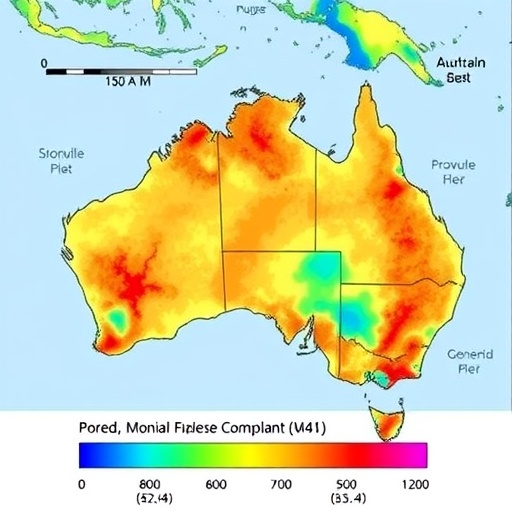Recent explorations into atmospheric pollutants have uncovered fascinating findings about a compound that has piqued the interest of both environmental scientists and public health officials. The natural product 2,4,6-tribromoanisole (TBA), a polyhalogenated compound, has been identified in representative Australian passive air samples as a predominant pollutant. This discovery marks a significant milestone in understanding the impact of such compounds on environmental health and underscores the urgent need for further research into their prevalence and effects.
The research conducted by Schweizer, Wang, and Paxman highlights the necessity of monitoring airborne pollutants, particularly polyhalogenated compounds, which are known for their persistence in the environment and potential toxicity. TBA is not a commonly discussed contaminant, yet its presence in passive air samples signals a need for increased vigilance regarding halogenated organic compounds. These substances, often derived from industrial processes, have raised concerns due to their bioaccumulative nature and potential to disrupt endocrine systems.
TBA is characterized not only by its chemical structure but also by its sources and pathways into the atmosphere. As a metabolite of chemical treatments used in the production of certain wood products, TBA’s detection in air samples can be linked to industrial emissions and residential uses, such as in brominated flame retardants. The implications of such findings are profound, as they suggest that everyday materials may contribute to environmental pollution more than previously thought.
In the course of the study, researchers utilized passive air sampling methods, which are increasingly recognized for their effectiveness in capturing a wide range of volatile organic compounds. These methodologies allow for the assessment of long-term exposure to air pollutants, as opposed to short-term, point-in-time monitoring techniques. By employing such strategies, the study yielded robust data indicating not only the presence of TBA but also its relative abundance compared to other halogenated compounds in the atmosphere.
The study presents some striking statistics that reveal the scale at which TBA has infiltrated the environment. Sample analysis showed TBA consistently appeared in concentrations significantly higher than other polyhalogenated constituents. These findings underscore a pressing need for public awareness regarding indoor air quality and the implications of long-term exposure to such contaminants.
Research on halogenated compounds typically involves concerns regarding human health effects. TBA, like many brominated compounds, has been associated with a range of negative health impacts including endocrine disruption and potential carcinogenic effects. Additionally, the persistence of TBA in the environment raises alarm regarding bioaccumulation in food chains, possibly affecting wildlife and humans alike. Therefore, identifying TBA as a dominant pollutant elevates the urgency in addressing air quality regulations to better safeguard public health.
Moreover, the presence of TBA in the air also raises questions about its origins and the broader environmental context. Investigations into the pathways by which TBA enters the atmosphere are critical for developing mitigation strategies. Whether through industrial emissions or degradation of consumer products, understanding the origins of TBA can inform regulatory frameworks aimed at curbing air pollution.
This groundbreaking research highlights the critical intersection of environmental science and public health policy. As TBA emerges as a principal player among airborne contaminants, it becomes increasingly vital for environmental agencies and policymakers to take note of its potential implications. Comprehensive air quality assessments can lead to more stringent regulations aimed at preventing exposure to harmful substances, especially in vulnerable communities.
The implications of this study extend beyond merely identifying pollutants; they instigate vital discussions about risk management strategies. With growing concerns surrounding the biochemical effects of halogenated compounds, it’s essential that stakeholders invest in further research to elucidate the pathways, persistence, and impacts of TBA and related substances. Future studies must focus on not just detection, but also on understanding the mechanisms through which these compounds affect human health and ecosystems.
As conversations about climate change and pollution intensify globally, studies like this serve as reminders of the myriad challenges that remain. Environmental scientists, policymakers, and the public must work collaboratively to address emerging pollutants and their sources effectively. Raising awareness about the presence of compounds like TBA catalyzes public interest and galvanizes communities into action, fostering a culture of vigilance and proactive environmental stewardship.
In closing, the findings surrounding 2,4,6-tribromoanisole represent a confluence of environmental science, public health, and consumer product regulation. As researchers continue to shine a light on the ramifications of airborne pollutants, communities must remain informed and engaged. Staying informed about such studies highlights the responsibility of every individual to contribute to the health of our planet and, ultimately, our well-being.
In the grand narrative of environmental research, the emergence of TBA as a predominant air pollutant serves as a crucial chapter that emphasizes vigilance. Understanding such threats to air quality will equip societies to implement necessary changes—ranging from regulatory action to changes in consumer behavior—that foster healthier living environments. The path forward is clear: enhance monitoring, promote sustainability, and ensure that future generations inherit a cleaner, more breathable world.
Subject of Research: The prevalence of the polyhalogenated compound 2,4,6-tribromoanisole in Australian passive air samples.
Article Title: The natural product 2,4,6-tribromoanisole is the predominant polyhalogenated compound in representative Australian passive air samples.
Article References:
Schweizer, S., Wang, X., Paxman, C. et al. The natural product 2,4,6-tribromoanisole is the predominant polyhalogenated compound in representative Australian passive air samples.
Environ Monit Assess 197, 1242 (2025). https://doi.org/10.1007/s10661-025-14638-7
Image Credits: AI Generated
DOI: 10.1007/s10661-025-14638-7
Keywords: 2,4,6-tribromoanisole, air quality, environmental health, polyhalogenated compounds, pollution.




